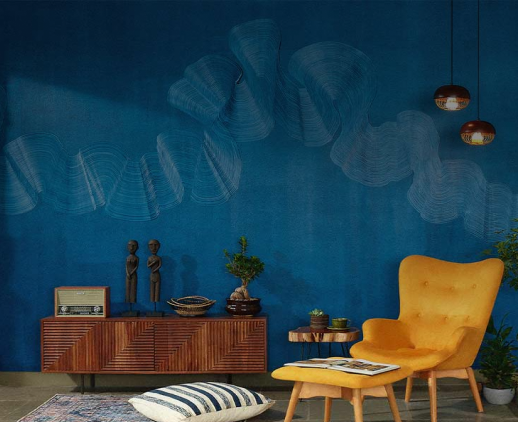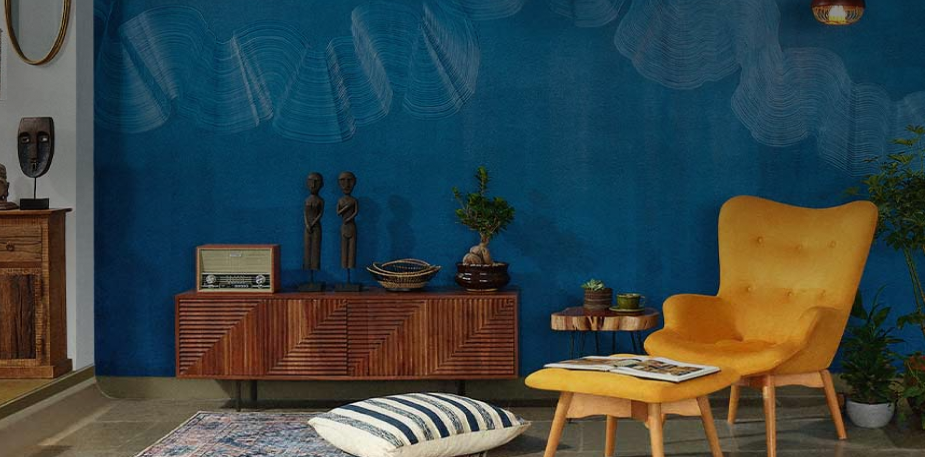Get your home interior design budget estimate
A Mumbai flat with a dramatic vision board and generous sea views

Rajiv Saini doesn’t do loud or flamboyant. Yet the homes that bear his unmistakable touch are as extraordinarily noticeable, more in fact, than others that try so hard to be. Quiet sophistication and a controlled aesthetic have consistently been strong elements of his design language. But over the course of two decades since the interior designer founded Rajiv Saini & Associates and began his professional journey, his visual vocabulary has evolved into a more restrained form, distilled down to a purer, more refined palette. “I see a certain refinement in my approach and I am happy about it,” he says. It is this light, crisp elegance that is on such remarkable display in this third-floor apartment in south Mumbai’s iconic Samudra Mahal building—understated with clean-lined architectural furniture and white walls, richly furnished by the expansive sea views. The designer spoke to us about this project, which he designed along with firm associate Ankush Bhandari, how his aesthetic has evolved and the integral role art plays in all his projects.
How did you implement and execute the vision you had for it?
RS: At about 2,000 square feet, this apartment is certainly not small by Bombay standards, but it was still relatively compact. There was little manoeuvring room when it came to the layout, since this building has walls made of RCC, not just the columns. Everything else, however, was gutted, including the floor and ceilings.
From the outset itself, given the volume that we had to work with, I was clear that it needed to be a visually light space. In smaller homes, you don’t want the space to be weighed down by bulky furniture. In this case, there were also the magnificent ocean views to consider. We wanted to make sure nothing obstructed them from the line of sight. Everything from the material palette to the furniture was done keeping these points in mind. Added to that, we also made sure they had enough storage space. Every inch of the construction detail was looked into and examined as potential storage area—every corner, alcove, the ceiling, the thickness of shutters was viewed through that lens.

Most rooms in the apartment benefit from views of the ocean and palms. The ‘Gilda’ chair by Carlo Mollino sits alongside the linen-covered sofa and custom coffee table. The painting is by artist Muzzumil Ruheel from art gallery TARQ.
The house has a very crisp aesthetic. How did you go about accomplishing that?
RS: It circles back to the necessity of keeping the space visually light. The curation of the furniture has played a dominant role in ensuring that. We wanted pieces that gave primacy to functionality; the decorative aspect would follow. Ergonomic, minimal, economical in terms of the resources used to make them—they were important elements that were considered to get the crisp, sharp and visually light aesthetic. This steered me towards what can be termed as architects’ pieces—those that have been made by pure architects rather than designers. They are all rationalist designs, driven by reducing the form to its basic and classic proportions. Like the Le Corbusier chairs in the living room, or the Charlotte Perriond cabinet in the TV room, even the living-room sofas, though they’re newer than the mid-century pieces picked out. And most importantly, they don’t block the sea view.

The family room has timber panelling on the ceiling and one wall. A lime-coloured linen sofa faces a custom coffee table on a vintage Turkish kilim. The black uplighter is by Italian lighting brand Oluce.

A blue sodalite stone screen conceals the passage leading to the kitchen and service areas. The table and chairs were kept all black to contrast with the grey floor and blue screen. A Tanya Goel canvas hangs above a polished stainless steel console.

The Gio Ponti-inspired desk was custom-made. Ceramic artwork on the wall above is by Singapore-based Madhvi Subrahmanian. Brazilian walnut panelling opposite the bed conceals some storage.
Did you custom-make any pieces?
RS: There are the brass bedside tables cantilevered off the walls, the four circular tables in the living room, the screen made with natural blue sodalite stone, among others. The screen was an important factor in offering a degree of privacy to the living-dining area, since the front door opens into it. The screen also blocks the kitchen and utility areas from sight and can be dismantled to allow for the moving of the large appliances.
How much of a role does art play in your process, given the way that it interacts with the design that makes it seem almost organically tied into the aesthetic?
RS: I have lived with art for so long now that it is unthinkable for me to not have it as an integral interior element. It isn’t a conscious thought; rather, it’s inextricable to the process. Now clients too have come to expect advice on art, its selection and placement when they come to me to do their homes. For this apartment, though the couple was accustomed to more traditional, figurative and narrative paintings, we went with more abstract works that related well with the overall look of the place and the design we had put together.
What kind of advice do you give clients on art matters?
RS: While selecting works, I never impose my sensibility on a client. I have conversations with them about artworks and artists, and take my cues from these discussions to narrow down the selection they would enjoy in their spaces. The one thing I do tell clients is to not look at art as an investment; it should be acquired for its own merit.
You also shouldn’t immediately start thinking about where to place it (unless it’s a large work); if it was compelling enough for you to buy, it will find a spot in your house. Ultimately, it is all about making connections—between the painting and the space, between the painting and what’s happening around it in the space, between the inside and the outside, between the narrative of different works.
Designing is such an organic, internal process, as is its evolution, but is there anything about your approach that you felt has changed noticeably?
RS: I want design to be less fussy, more refined, definitely more restrained—I want simple. But that doesn’t mean that the detailing has become any lesser. In fact, it has increased. Often, ‘simple’ requires more detail than a loud design. It is often more complicated to achieve, more challenging to perfectly execute, because everything—the materials, the way you use them—it all matters more.

Get Started with your interior design journey with us!
Speak to our design professionals
What’s the status of your home possession?
What’s the condition of your home/space?
Will you be living in your space during the renovation?
 Previous Question
Previous Question
Is your interior design budget over 4 lakhs?
 Previous Question
Previous Question
Book next available appointment slots with our experts!
Please Select Date and Day
 Previous Question
Previous Question

Something went wrong!
We were unable to receive your details. Please try submitting them again.

Appointment Scheduled!
Thank you for giving an opportunity to Asian Paints Beautiful Homes Service! Our Customer Experience Specialist will get in touch with you soon.
Appointment Date & time
Thank You!
Our team will contact you for further details.
What’s the status of your home possession?
What’s the condition of your home/space?
Will you be living in your space during the renovation ?
 Previous Question
Previous Question
Is your interior design budget over 4 lakhs?
 Previous Question
Previous Question
Book next available appointment slots with our experts!
DEC 2023
Please Select Date and Day
 Previous Question
Previous Question

Something went wrong!
We were unable to receive your details. Please try submitting them again.

Appointment Scheduled!
Thank you for giving an opportunity to Asian Paints Beautiful Homes Service! Our Customer Experience Specialist will get in touch with you soon.
Appointment Date & time
17 Oct 23, 03.00PM - 04.00PM












































